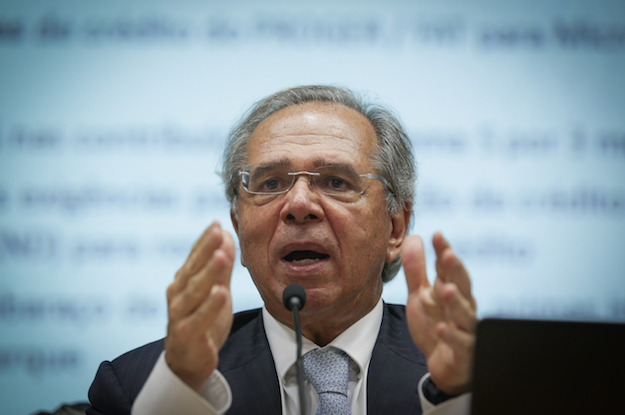Part of a continuing series on how Latin America can overcome a decade of slow economic growth.
Economic analysts, myself included, once thought that Brazil could reach a per capita income equal to Spain or Portugal by the early 2020s. Instead, the 2010s seem destined to go down as a lost decade for Brazil in many of the ways that matter most: productivity, living standards, health, education, and fairness.
Brazil’s future remains uncertain. Will it catch up to what might have been, with GDP growth of 4-5% per year, or will it fall further behind the more advanced economies?
Brazilians are often inspired by an optimistic view of their future in a great and prosperous nation; hence their frustration today. But that bedrock of optimism suggests that the social consensus for a compelling new model for growth can indeed emerge. The current legislative session, which opened Feb. 1, offers a first step forward.
In coming weeks and months, Congress is expected to debate numerous ideas to reignite Brazil’s flagging economy. This is an opportunity to rethink the future and correct past missteps. To start, the below three categories of reform could help move Brazilian society toward a consensus-driven economic model that delivers more for everyday people.
Freeing up fiscal resources
The first order of business will be to gain control of public finances. Pension payments and payroll spending on public employees account for almost three-fourths of Brazilian federal government spending. The amount that Brazil spends on social security and pension payments (14% of GDP) is out of all proportion for a relatively young country. Its civil service wage bill, at 13% of GDP, tops the OECD charts and is almost twice as high as other Latin American economies.
The administration of President Jair Bolsonaro pushed through a social security reform in 2019 that increased retirement ages and reduced inequalities arising from so-called special retirement regimes, generous pension programs that benefit powerful interest groups, such as the military, the judiciary and other public sector employees. The reform was a notable political victory, but over the next 10 years the resulting legislation will deliver only one-half of the fiscal adjustment in terms of GDP that Brazil needs from pension reform. Brazilian governments will need to push reform further in the next five to 10 years.
Then there is the question of the Brazilian government’s bloated payroll. Brazil’s best and brightest, including its potential entrepreneurs and business leaders, are currently drawn into public service, attracted by employment stability, higher salaries and secure retirements. In fact, employment in the federal government has increased by 28% over the last 20 years. Administrative reform, drafts of which are already circulating, would involve giving the federal government, as well as states and municipalities, much greater ability to redefine antiquated work rules, reallocate employees and check the steady rise in spending on wages and salaries. Public employees will resist such reform, but some version of administrative reform is necessary to free up fiscal resources for investment and social programs.
Enhancing efficiency
A second opportunity for progress is in tax and trade policy reform. Outside of agriculture, Brazil is losing the global productivity race. Tax reform and trade liberalization could change that relatively quickly.
A long-postponed tax reform will likely be taken up in 2020, and not a moment too soon. Brazil’s tax burden is in excess of 33% of GDP, well beyond global standards. The tax system is complex and contributes to social inequality, as most taxes fall upon consumption rather than income or wealth.
The key reform under discussion is the creation of a national value-added tax (VAT), with uniform tax rates across all products. A VAT would replace a bewildering patchwork of state-levied taxes as well as various federal taxes that raise compliance costs for government and business and contribute to resource misallocation.
Basic fairness questions permeate the debate on tax reform. Government tax subsidies for corporations have risen to almost 7% of GDP. Specific business sectors, and even some particular companies, are favored, with large subsidies also liberally provided to smaller firms based on scant cost-benefit analysis. Higher-earning Brazilians are lightly taxed, so there is room to raise marginal income tax rates, including for highly paid professionals who currently use loopholes to pay less than their fair share of income taxes.
Turning to trade reform, Brazil’s most pressing need is to increase productivity in manufacturing and services, lest it risk falling further behind the rest of the world. Here, Brazil’s success in agriculture can be instructive. For most of the 2000s, productivity in Brazilian agriculture, which is barely protected from competition at all, has soared by leaps and bounds. If the government could reduce protections for industry and services while at the same time investing heavily in innovation-related R&D, globally minded Brazilian businesses could quickly create better-paying jobs in urban areas full of educated, underutilized workers.
Brazil has a longstanding preference for multilateral trade agreements, which has resulted in endlessly complicated negotiations (e.g., the EU-Mercosur Agreement). Unilateral trade liberalization might break through the logjam of interest group politics. The Changing Role of the State, a recent volume I helped organize, provides a map to reform. In it, Sandra Rios argues for four ideas to improve Brazil’s trade system: a unilateral tariff reduction with a focus on industrial goods; dismantling non-tariff barriers; simultaneous negotiation of preferential trade agreements to lock in unilateral reforms; and dismantling of industrial policy instruments with embedded protectionist barriers. Resistance from business groups that benefit from the status quo will be fierce, but this issue must be addressed.
Triggering growth
The state of economic infrastructure in Brazil is appalling. Also in The Changing Role of the State, Claudio Frischtak observes that the country’s stock of economic infrastructure (transportation, telecoms, power and water/wastewater) is about 30% of GDP, when it should ideally be at least 60% (a level last reached in Brazil in 1984). Most of Brazil’s infrastructure dates back at least 30-40 years, and signs of physical decay caused by low investment and deferred maintenance are evident.
The minimum target should be an infrastructure stock on the order of 60% of GDP within the next 20 years. The good news is that this infrastructure push could raise Brazilian GDP by 1.5%-2% per year in the short-term, with additional dividends down the road.
The bad news is that a big push on infrastructure would require numerous preliminary steps that seem unlikely in the immediate future. To mobilize domestic and foreign private capital, Brazil would need more centralized investment planning, which could be anathema to liberal economic purists. Legal and regulatory frameworks in many sectors are also in disarray, oil and gas and electric energy being two examples. Judicial insecurity is a constant risk in Brazil, with judges intervening in contracts without a clear understanding of the economic impact. And any long-term investors in Brazil today, domestic and foreign, are bound to be discouraged by the polarization in society. Despite these obstacles, higher rates of economic growth require this huge push in infrastructure.
Conclusion
While the rate of economic growth lags, Brazilian society is bubbling over with practical proposals in the above and other areas for reform. The reforms do not promise growth miracles, but miracles are not what is needed. Rather, the first step is a broadly supported vision in Brazilian society that a smarter, fairer, more sustainable Brazil is indeed within reach.
—
Trebat is the director of the Columbia Global Center in Rio de Janeiro








